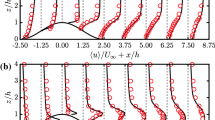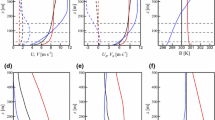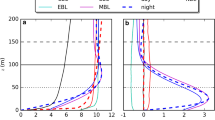Abstract
In a series of wind-tunnel experiments conducted at the St. Anthony Falls Laboratory, a wind-turbine model was exposed to three different thermal regimes (neutral, weakly stable and weakly convective flows) in three simple arrangements relevant to wind-farm applications: single turbine in the boundary-layer, aligned turbine-turbine, and an upwind three-dimensional sinusoidal hill aligned with the turbine. Results focus on the spatial evolution of large-scale motions developing over the different thermal and topographic boundary conditions, and on their influence on the mean and fluctuating angular velocity of the turbine rotor. As compared to the single turbine case, both the upwind hill and turbine caused a reduction in the mean angular velocity regardless of the thermal regime; the turbine angular velocity fluctuations always decreased with a turbine upwind, which depleted the energy of the large structures of the flow; however such fluctuations decreased (increased) under stably stratified (convective) conditions when the hill was present. Pre-multiplied spectra of the rotor angular velocity and two-point correlation contours of the streamwise velocity component confirmed a non-trivial link between thermal stratification and terrain complexity. It is inferred that the thermal effects occurring in the three different boundary-layer regimes modulate the spanwise motion of the hill wake and define whether the hill shelters or exposes the turbine to enhanced large-scale energetic motions.















Similar content being viewed by others
References
Adrian RJ, Meinhart CD, Tomkins CD (2000) Vortex organization in the outer region of the turbulent boundary-layer. J Fluid Mech 422:1–54
Adrian RJ, Christensen KT, Liu ZC (2000) Analysis and interpretation of instantaneous turbulent velocity fields. Exp Fluids 29:275–290
AWEA 1st quarter 2012 Public Market Report (2012) American Wind Energy Association (AWEA), pp 1–21
Ayotte KW, Hughes DE (2004) Observations of boundary-layer wind-tunnel flow over isolated ridges of varying steepness and roughness. Boundary-Layer Meteorol 112:525–556
Balakumar B, Adrian R (2007) Large scale and very large-scale motions in turbulent boundary-layers and channel flows. Phil Trans R Soc A 365:665–681
Buck JW, Renne DS (1985) Observations of wake characteristics at the Goodnoe Hills MOD-2 array. National Technical Information Service, Alexandria
Cal RB, Lebron J, Castillo L, Kang HS, Meneveau C (2010) Experimental study of the horizontally averaged flow structure in a model wind-turbine array boundary layer. J Renew Sust Energy 2:013106
Calaf M, Meneveau C, Parlange M (2011) Large eddy simulation study of a fully developed thermal wind-turbine array boundary-layer. Ercoftac SER 15:239–244
Carper MA, Porté-Agel F (2004) The role of coherent structures in subfilter-scale dissipation of turbulence measured in the atmospheric surface layer. J Turbul 5:N40
Castro IP, Snyder WH (1982) A wind-tunnel study of dispersion from sources downwind of three-dimensional hills. Atmos Environ 16–8:1869–1887
Chamorro LP, Porté-Agel F (2010) Effects of thermal stability and incoming boundary-layer flow characteristics on wind-turbine wakes: a wind-tunnel study. Boundary-Layer Meteorol. doi:10.1007/s10546-010-9512-1
Chamorro LP, Porté-Agel F (2009) A wind-tunnel investigation of wind-tubine wakes: boundary-layer turbulence effects. Boundary-Layer Meteorol 132:129–149
Chamorro LP, Arndt R, Sotiropoulos F (2011) Turbulent flow properties around a perfectly staggered wind-farm. Boundary-Layer Meteorol 141:349–367
Chamorro LP, Porté-Agel F (2011) Turbulent flow inside and above a wind-farm: a wind-tunnel study. Energies 4:1916–1936
Chamorro LP, Guala M, Arndt R, Sotiropoulos F (2012) On the evolution of turbulent scales in the wake of a wind-turbine model. J Turbul 13:1–13
Chamorro LP, Hill C, Morton S, Ellis C, Arndt REA, Sotiropoulos F (2012) On the interaction between a turbulent open channel flow and an axial-flow turbine. J Fluid Mech. doi:10.1017/jfm.2012.571
Chauhan K, Hutchins N, Monty J, Marusic I (2013) Structure inclination angles in the convective atmospheric surface layer. Boundary-Layer Meteorol 147:41–50
Cheng Y, Parlange MB, Brutsaert W (2005) Pathology of Monin–Obukhov similarity in the stable boundary-layer. J Geophys Res-Atmos 110:2156–2202
Corten GP, Schaak P, Hegberg T (2004) Velocity profiles measured above a scaled wind-farm. Eur. Wind Conference, Nov 2004, London, pp 1–10
Fedorovich E, Kaiser P, Rau M, Plate E (1996) wind-tunnel study of turbulent flow structure in the convective boundary-layer capped by a temperature inversion. J Atmos Sci 53(9):1273–1289. doi:10.1175/1520-0469(1996)053
Finnigan JJ, Raupach MR, Bradley EF, Aldis GK (1990) A wind-tunnel study of turbulent flow over a two-dimensional ridge. Boundary-Layer Meteorol 50:277–317
Frandsen S (1992) On the wind-speed reduction in the center of large clusters of wind-turbines. J Wind Eng Ind Aerodyn 39:251–265
Gravdahl AR, Rorgemoen S, Thogersen M (2002) Power prediction and siting-when the terrain gets rough. In: The World Wind Energy Conference and Exhibition. pp 1–4
Gonzáles-Longatt F, Wall P, Terzija V (2012) Wake effect in wind-farm performance: steady-state and dynamic behavior. Renew Energy 39:329–338
Guala M, Hommema SE, Adrian RJ (2006) Large-scale and very-large-scale motions in turbulent pipe flow. J Fluid Mech 554:521–542. doi:10.1017/S0022112010004544
Guala M, Metzger M, McKeon BJ (2011) Interactions within the turbulent boundary-layer at high Reynolds number. J Fluid Mech 666:573–604
Guala M, Tomkins CD, Christensen KT, Adrian RJ (2012) Vortex organization in a turbulent boundary layer overlying sparse roughness elements. J Hydraul Res 50(5):465–481
Hancock PE, Pasheke F (2014) Wind-tunnel simulation of the wake of a large wind turbine in a stable boundary layer. Part 1: The boundary-layer simulation. Boundary-Layer Meteorol 151:3–21
Hancock PE, Pascheke F (2014) wind-tunnel simulation of the wake-flow of a large wind-turbine in a stable boundary layer: part 2, the wake-flow. Boundary-Layer Meteorol 151:23–37
Harman IN, Finnigan JJ (2013) Flow over a narrow ridge covered with a plant canopy: a comparison between wind-tunnel observations and linear theory. Boundary-Layer Meteorol 147:1–20
Howard KB, Chamorro LP, Guala M (2013) An experimental case study of complex topographic and atmospheric influences on wind-turbine performance, AIAA Aerospace Sciences Meeting, Dallas
Howard KB, Hu JS, Chamorro LP, Guala M (2015) Characterizing the response of a wind-turbine model under complex inflow conditions. Wind Energy 18(4):729–743. doi:10.1002/we.1724
Hu H, Yang Z, Sarkar P (2012) Dynamic wind loads and wake characteristics of a wind-turbine model in an atmospheric boundary-layer wind. Exp Fluids 52:1277–1294
Hong J, Toloui M, Chamorro LP, Guala M, Howard K, Riley S, Tucker J, Sotiropoulos F. (2014) Natural snowfall reveals large-scale flow structures in the wake of a 2.5-MW wind-turbine. Nature COMM 5
Husien W, El-Osta W, Dekam E (2013) Effect of the wake behind wind rotor on optimum energy output of wind-farms. Renew Energy 49:128–132
Hutchins N, Marusic I (2007) Evidence of very long meandering features in the logarithmic region of turbulent boundary-layers. J Fluid Mech 579:1–28
Ivanova LA, Nadyozhina ED (2000) Numerical simulation of wind-farm influence on wind flow. Wind Energy 24:257–269
Kanda I, Yamao Y, Uehara K, Wakamatsu S (2013) Particle-image velocimetry measurements of separation and re-attachment of airflow over two-dimensional hills with various slope angles and approach-flow characteristics. Boundary-Layer Meteorol. doi:10.1007/s10546-013-9806-1
von Kármán T (1911) Nachr. Ges. Wissenschaft. Göttingen pp. 509-517
Lebron J, Castillo L, Meneveau C (2012) Experimental study of the kinetic energy budget in a wind-turbine streamtube. J Turbul. doi:10.1080/14685248.2012.705005
Marusic I, Heuer WDC (2007) Reynolds number invariance of the structure inclination angle in wall turbulence. Phys Rev Lett 99:114504
Markfort CD, Zhang W, Porté-Agel F (2012) Turbulent flow and scalar transport through and over aligned and staggered wind-farms. J Turbul 13(1):N33. doi:10.1080/14685248.2012.709635
Melling A (1997) Tracer particles and seeding for particle image velocimetry. Meas Sci Technol 8:1406–1416
Meneveau C (2012) The top-down model of wind-farm boundary-layers and its applications. J Turbul 13:N7
Neff DE, Meroney RN (1997) Wind-tunnel modeling of hill and vegetation influence on wind-power availability. In: Proceedings from 2nd European and African conference on wind engineering, June 1997
Ohya Y, Neff DE, Meroney RN (1997) Turbulence structure in a stratified boundary-layer under stable conditions. Boundary-Layer Meteorol 83(1):139–161
Pacific Northwest Laboratory (1986), Wind Energy Resource Atlas of the United States
Politis ES, Prospathopoulos J, Cabezón D, Hansen KS, Chaviaropoulos PK, Barthelmie RJ (2012) Wake effects in large wind-farms in complex terrain: the problem, the methods and the issues. Wind Energy 15(1):161–182
Porté-Agel F, Wu YT, Lu H, Conzemius RJ (2011) Large-eddy simulation of atmospheric boundary-layer flow through wind-turbines and wind-farms. J Wind Eng Ind Aerodyn 99:154–168
Singh A, Howard KB, Guala M (2014) On the homogenization of turbulent flow structures in the wake of a model wind-turbine. Phys Fluids 26:025103. doi:10.1063/1.4863983
Smits AJ, McKeon BJ, Marusic I (2011) High-Reynolds number wall turbulence. Annu Rev Fluid Mech 43:353–375
Snyder WH, Britter RE (1987) A wind-tunnel study of the flow structure and dispersion from sources upwind of three-dimensional hills. Atmos Environ 21–4:735–751
Sørensen JN (2011) Aerodynamic aspects of wind energy conversion. Annu Rev Fluid Mech 43:427–448
Stull RB (1988) An introduction to boundary-layer meteorology. Kluwer Academic Publishers, Dordrecht, 670 pp
Takahashi T, Kato S, Murakami S, Ooka R, Yassin MF, Kono R (2005) wind-tunnel tests of effects of atmospheric stability on turbulent flow over a three-dimensional hill. J Wind Eng Ind Aerodyn 93: 155–169
Tampieri F, Mammarella I, Maurizi A (2003) Turbulence in complex terrain. Boundary-Layer Meteorol 109: 85–97
Toloui M, Riley S, Hong J, Howard K, Chamorro LP, Guala M, Tucker J (2014) Measurement of atmospheric boundary-layer based on super-large-scale particle image velocimetry using natural snowfall. Exp Fluids 55(5):1–14
Troldborg N, Larsen GC, Madsen HA, Hansen KS, Sørensen JN, Mikkelsen R (2011) Numerical simulations of wake interaction between two wind-turbines at various inflow conditions. Wind Energy 7(14):859–876
Vermeer LJ, Sørensen JN, Crespo A (2003) Wind turbine wake aerodynamics. Prog Aerosp Sci 39:467–510
Yang Z, Oxbay A, Sarkar P, Hu H (2012) An experimental investigation on the wake interference of wind-turbines sited over complex terrains. AIAA ASM Nashville, Jan 2012
Yang X, Kang S, Sotiropoulos F (2012) Computational study and modeling of turbine spacing effects in infinite aligned wind-farms. Phys Fluids 24:115107. doi:10.1063/1.4767727
Yang X, Howard KB, Guala M and Sotiropoulos (2015) Effects of a three dimensional hillon the wake characteristics of a model wind-turbine. Phys Fluids 27(2):025103
Wu Y, Christensen KT (2010) Spatial structure of a turbulent boundary-layer with irregular surface roughness. J Fluid Mech 655:380–418
Wu YT, Porte-Agel F (2013) Simulation of turbulent flow inside and above wind farms: model validation and layout effects. Boundary-Layer Meteorol 146(2):181–205
Zahle F, Sørensen NN (2011) Characterization of the unsteady flow in the nacelle region of a modern wind-turbine. Wind Energy 14:271–283
Zhang W, Markfort CD, Porté-Agel F (2013) Wind turbine wakes in a convective boundary-layer: a wind-tunnel study. Boundary-Layer Meteorol 146:161–179
Acknowledgments
The authors acknowledge support from the Institute on the Environment (IONE), University of Minnesota (IREE Early Career Award) and James Tucker, for designing the thermal control system to provide the wind-tunnel stratification capability.
Author information
Authors and Affiliations
Corresponding author
Rights and permissions
About this article
Cite this article
Howard, K.B., Chamorro, L.P. & Guala, M. A Comparative Analysis on the Response of a Wind-Turbine Model to Atmospheric and Terrain Effects. Boundary-Layer Meteorol 158, 229–255 (2016). https://doi.org/10.1007/s10546-015-0094-9
Received:
Accepted:
Published:
Issue Date:
DOI: https://doi.org/10.1007/s10546-015-0094-9




